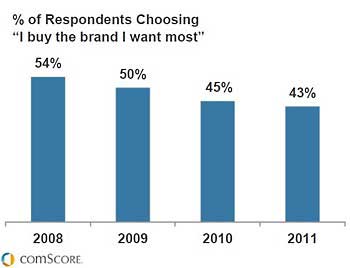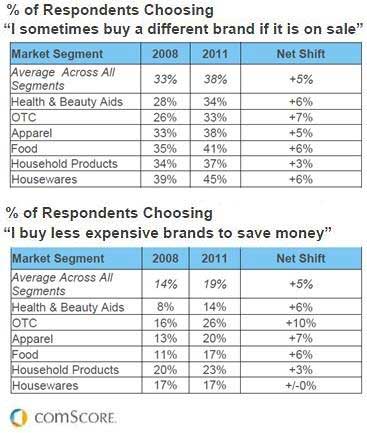The US recession has affected consumers' purchasing behaviors across various product categories, leading them to increasingly "buy down," or purchase less expensive brands in order to save money, according to new report by comScore.
Technology is enabling such price-seeking behaviors with the Internet cited as the most popular channel for comparison shopping among every generation except seniors.
Below, additional findings The Effects of the Recession on Brand Loyalty and "Buy Down" Behavior: 2011 Update, based on a survey of 1,000 female consumers, conducted by comScore.
Female consumers, who are estimated to influence from 60% to 85% of household purchasing decisions, have become more price-conscious: The percentage women surveyed who buy the brand they want most has fallen to 43% as of July 2011, down 11 percentage points from 54% in 2008:

The Buy-Down Effect: Shopping Sales and Converting To Less Expensive Brands
The drop in likelihood to shop for the brand wanted most is attributable to two factors: 1) Buying a comparable brand when on sale; and 2) Converting to less expensive brands.
One in five shoppers (19%) converted to less expensive, generally private label, brands to save money in 2011, up from 14% in 2008.
Across market segments, over-the-counter (OTC) products posted the largest net shift for both types of buy downs, up 7% for buying on sale and up 10% for buying less expensive brands.

Houseware items (small appliances) registered no net shift for buying less expensive brands, but a prominent 6-point gain in buying other brands on sale. When buying durable goods (typically bought relatively infrequently) consumers appear more hesitant to try cheaper brands, but are still looking to save money by buying premium brands when they are on sale.
Looking for great digital marketing data? MarketingProfs reviewed hundreds of research sources to create our most recent Digital Marketing Factbook (May 2010), a 296-page compilation of data and 254 charts, covering email marketing, social media, search engine marketing, e-commerce, and mobile marketing. Also check out The State of Social Media Marketing, a 240-page original research report from MarketingProfs.
Channels for Price-Seeking Behavior
Technology is enabling shoppers' price-seeking behavior.
Asked which channels they use to do comparison shopping (in order to find the lowest price), behaviors vary by age:
- Internet (PC-based) is the most popular method of choice for every generation except seniors: 63% of Millennials (under age 30), 60% of Gen-X (age 30-44) and 57% of Boomers (age 45-50) use the Internet for comparison shopping, compared with 50% of Seniors (age 60+).
- Mobile is still relatively small: 15% of Millennials and 10% of Gen-X consumers use mobile devices to comparison shop.
- 58% of Seniors use the newspaper to comparison shop, as do nearly one-half (47%) of Gen-X consumers.

About the data: Findings are from comScore's study of US consumers, based on a survey of 1,000 adult female shoppers, fielded in July 2011.



